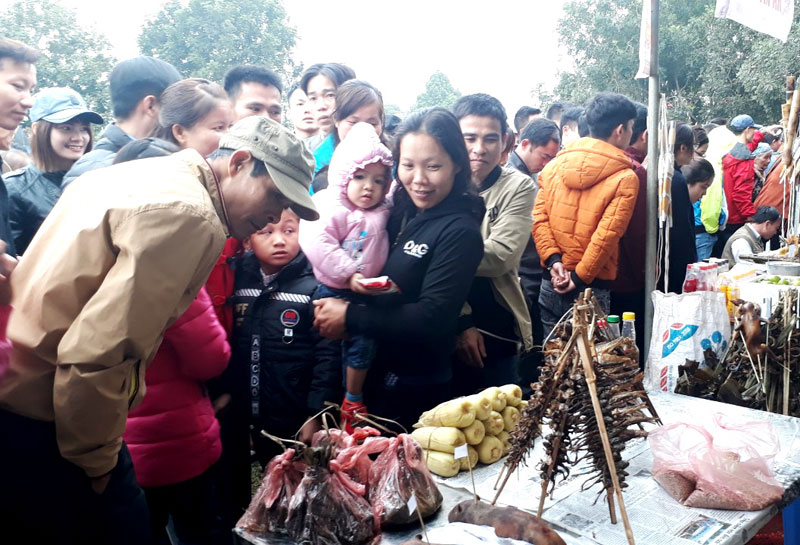
(HBO) – In traditional festivals, especially those organised after the lunar New Year, the presence of traditional dishes for display or selling has become a familiar image. It can be said that traditional cuisine has been existing and promoted in local festivals.

At
Muong Bi Khai ha (going down the field) festival, food stalls always draw a
crowd of many visitors.
The
Muong Bi Khai ha (going down the field) festival is an address visitors cannot miss
if wanting to learn about the Muong ethnic group’s culture. At this year’s
festival, each town and commune in Tan Lac district had a booth displaying its
specialties, in which dishes bearing Muong people’s cultural characteristics
always attract a lot of visitors.
On
the path to the festival, bamboo-tube rice, grilled fish and hot vegetable
steamers left strong impressions on visitors. Do Nhan commune brought its
attractive traditional dishes to this year’s festival, including grilled "dam
xanh” fish, steamed vegetables with 18 different kinds, steamed stream fish,
and seven-colour sticky rice. For Muong people, steaming and grilling have long
been the two most typical ways of cooking. They also like eating forest
vegetables with bitter taste or cooking meat with sour bamboo shoots and "la
lom” – a typical kind of leaf of the Muong people. Those typical dishes were
easily found in Muong Bi Khai ha festival. Steamed or grilled fish, chicken
meat fried with sour bamboo shoots, mixed vegetables, and bamboo-tube rice were
seen in almost all booths. In addition, many specialties in the mountainous
region, including frog, squirrel, and mouse, were also sold in the festival.
The
booths were busy at noon. The space under the bamboo canopy was an ideal place
for visitors to relax and enjoy traditional dishes of the Muong people./.
The People’s Committee of Lac Son district held a ceremony on April 28 to receive the provincial relic certificate for the ancient rock carving site at Suoi Co stream, located in My Thanh commune.
A special music show titled "The country is in the fullness of joy” has been held at Hoa Binh Square in Hoa Binh city in celebration of the 50th anniversary of the liberation of the South and national reunification (April 30, 1975–2025).
The People's Committee of Lo Son commune, Tan Lac district, has organised the local annual traditional stream fishing festival on April 19 - 20.
As a land deeply intertwined with human history and Vietnam’s millennia-long journey of nation-building and defence, Hoa Binh is often revered for its epic tales and legends.
Residents of Hoa Binh boast a rich cultural identity, reflected in their unique language, traditional attire, customs, and folk melodies – described as "sweet as honey, clear as a mountain stream.”
Lac Son district’s Vu ban town held the 2025 Truong Kha temple festival on April 12–13 (the 15th–16th days of the third lunar month). Since its revival in 2019, the festival has been organised every three years, preserving valuable intangible heritage while meeting the community’s cultural and spiritual needs.



